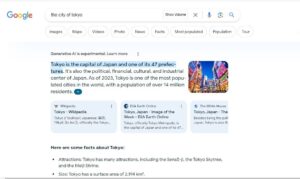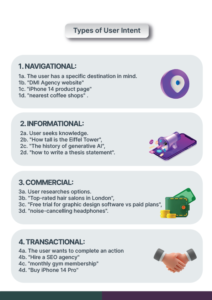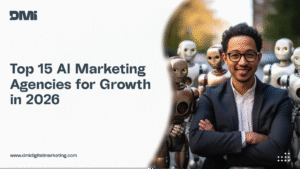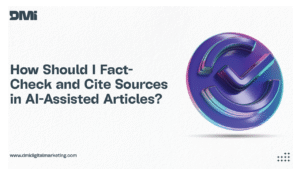Jump to Section
ToggleAs marketers, we must not only accept that the world around us is flexible and always changing but also anticipate how these changes will affect our work.
A new tech product, evolving consumer behaviour, economic shifts, and even global conflicts– like the one currently unfolding in Gaza– all emerge to reshape our attention and necessitate strategic adaptation.
Today, one of the most significant changes in digital marketing is the integration of generative AI in search.
Following the explosive growth of large language models like ChatGPT in 2023, Google introduced Search Generative Experience (SGE) to keep up with users’ evolving expectations for AI-powered search results.
Built with generative AI capabilities, SGE transforms the search landscape by providing personalized overviews, quick answers, and interactive content experiences to search queries.
According to industry forecasts, this new search experience will impact web traffic as searchers may get information from SERPs without visiting websites.
A recent study by BrightEdge also predicts that when it’s fully launched, SGE could affect marketer spending on Google ads by over $40 billion annually. That’s a significant risk.
In this blog post, we’ll explore SGE features and how to adjust your content to fit the established requirements of this emerging “search revolution.”
What’s Search Generative Experience (SGE)?
Search Generative Experience (SGE) is a new, evolving way to explore Google Search using generative AI features. Still, in the experimental stage, SGE allows users to access AI-generated insights for specific queries in their search results, removing the hassle of jumping from site to site.
Google SGE also allows users to ask follow-up questions. It anticipates your following query, offers additional information beyond the traditional search and provides links to external web pages if you wish to learn more about a topic in depth.
For example, learning about Japan’s capital, Tokyo, can be a more informative and immersive experience with SGE.
If you type “Tokyo” on Google, the AI-generated results will concisely summarise the city’s top attractions, food, and history. It’s like having a personalized tour guide in your hand.


Further Reading: An Overview of SGE
How does SGE work?
SGE uses large language models (LLMs) to analyze search queries and understand the user’s intent. Based on this analysis, SGE can generate informative summaries or curate existing content that best addresses the user’s needs.
But here, we will focus on how SGE results are displayed.
Currently, the results are given in 3 states: Automatic generation, User-initiated result, and No SGE result.
Automatic generation: This is when Google’s SGE provides its AI results upon users’ queries without any need to take extra steps or actions to trigger them. However, the AI overviews are sometimes partially collapsed states, as seen in the screenshot below.

User-initiated results: In this case, Google’s SGE requires the user to take action to produce its AI results, i.e., the user must manually generate its AI results.

No SGE result: In some cases, SGE will not generate AI results for a user’s query. This may be because the search engine has not found relevant or reliable information online. According to a study, only about 90% of search queries have SGE.

How will SGE impact SEO and PPC marketing?
SEOs and businesses relying on Google Search for traffic and conversion are racing to find out how SGE will impact web traffic from paid and unpaid searches–SEO and PPC. The findings so far point to both positive and negative sides.
SGE Impact on SEO
One significant discovery is that 94% of site links in Google SGE don’t usually match the top 10 SERP results that SEOs traditionally optimize for.
The study further explains that only about 4.5% of the time, the links in SGE match the top websites that rank high in regular searches.
Another study even shows that some websites ranking at the top of search results, including e-commerce, may be displaced to the second page or other lower positions because of SGE results.
Moreover, with AI-powered results surfacing directly within SGE, clicks on traditional web pages are predicted to decrease significantly for queries that provide clear and concise answers.
A study by the Wall Street Journal suggests that media sites could lose up to 40% of their SEO traffic due to this phenomenon.
SGE Impact on PPC
Pay-per-click campaigns may also need to adapt, as click-through rates (CTR) could decline if users find the information they need directly within SGE results.
SGE may create a scenario where advertisers have to compete for user attention not just with other ads, but also with Google’s AI-generated content.
There are speculations that part of the reason the SGE launch is being delayed is to help Google understand how it will impact clicks on search ads, which are a source of revenue for the search company.
The good news?
Organic content that aligns with user intent and offers a richer user experience through SGE functionalities (like summaries and interactive elements) could gain significant visibility.
Let’s explore how…
How to Optimize for Google’s SGE
1. Optimize Content as Multimedia Formats
With SGE, Google enhanced search by adding images, and videos that directly correspond to your question. This demonstrates SGE’s ability to synthesize information from various sources and present it in multimedia.
It’s a clear signal that optimising written SEO content is no longer just important.
It’s time to accommodate a wide variety of user tastes. Content on a page should be presented in various formats where necessary. Think compelling videos, high-quality images, and even embedded audio clips to create a more engaging experience.
An example of a content topic that might benefit from diversified content formats is a “how-to” guide. This could be presented as a blog post with a video tutorial or podcast episode.
Further Readings: Google Image SEO Best Practices and Video SEO Best Practices
2. Refine and Update Content Based on Performance on SGE Results
Brian Dean, founder of Blacklinko, a trusted SEO site, once shared an experience that was helpful in explaining these tips.
He published a high-quality article that became a reference for multiple other websites. However, months after publication, this article continued to rank on the second page of the Google search results page.
After a careful SEO audit, he discovered that the article performed less well than other high-ranking articles because it’s starved of an important element of SEO strategy, Search Intent.
With this discovery, he wrote the article from scratch and eventually ranked in the top three for the targeted keyword.
The lesson: With SGE still under development, refining and adjusting content based on post-publication performance will help us understand what Google prioritizes.
3. Prioritize Search Intent
SGE or no SGE, Google’s core mission has always been to deliver results that fulfil search or user intent.
Search intent is what the user ultimately tries to achieve with their search query.
Producing content that Google ranks well requires a thorough grasp of user intent, a step above identifying the terms users search for.
That means understanding when a keyword or search term has informational, navigational, commercial, or transactional intent.
Types of User Intent

* Navigational: The user has a specific destination in mind. DMI Agency website, iPhone 14 product page, nearest coffee shops.
* Informational: User seeks knowledge. (eg. How tall is the Eiffel Tower? What is the history of generative AI? How do you write a thesis statement?
* Commercial: User researches options. (eg. Top-rated hair salons in London, free trial for graphic design software vs paid plans, and noise-cancelling headphones.
* Transactional: The user wants to complete an action (eg. Hire an SEO agency, monthly gym membership, and Buy an iPhone 14 Pro
The critical difference between transactional and commercial queries is that the latter is about buying now, while the former is about gathering info before you buy, more like window shopping.
However, some search queries exhibit overlapping intent. The user might be considering a purchase but also seeking additional information.
This is why you must use automated user intent analysis tools like Cognitive SEO and Semrush’s Keyword Magic Tool.
After picking keywords and understanding user intent, analyze the top search results (SERP) to determine how your content can be more profound and informative.
Can you offer a more compelling narrative (stories, case studies) for informational searches?
Consider creating interactive elements or explainer videos for task-oriented searches if that is discovered as a content gap.
If it’s transactional searches, you should provide clear comparisons, highlight unique benefits, and showcase trust signals (reviews, guarantees).
For commercial searches, you may need to craft more compelling narratives, showcase product value propositions, and offer clear calls to action.
4. Target Long-Tail Keywords
Google’s SGE seems to be pushing users towards more detailed search queries with its ability to ask follow-up questions and provide detailed, conversational summaries.
These features suggest optimizing your content for long-tail keywords to maximize visibility. With it, you may better serve targeted user queries and increase the chance that your content will appear in SGE results.
Keyword research tools might be a great resource for uncovering long-tail keywords relevant to your content. Again, the goal is to offer a more accurate representation of user intent.
Tools like Google Keyword Planner, Keyword Generator, and Keyword Magic Tool are excellent choices for finding keywords related to your niche and with a substantial search volume.
Final Thoughts
Google maintained that it designed SGE to “highlight and drive attention to content on the web” and that its AI results will be “a jumping-off point to explore web content.”
That remains to be seen, and it will continue to open room for stakeholders to develop new strategies that could address potential challenges and opportunities associated with this evolving technology.
As a business that relies on Google for traffic and conversion, all eyes should be on the unfolding impacts of SGE on your online visibility and SEO strategy. Don’t be caught off guard!
Author
-

Yusuf Mutiat Temitope is a result-driven content writer with years of experience in conversion-driven content writing. Mutiat writes on digital marketing to drive business growth, provide insights on trending topics for the audience, and increase customer engagement.
View all posts SEO Content Writer





